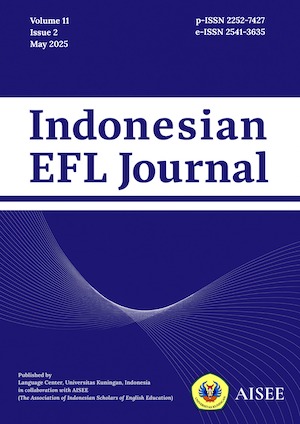BRIDGING THE LITERACY GAP WITH INTEGRATED MEDIA: EMPOWERING ELEMENTARY STUDENTS TO THRIVE
Abstract
The extended impact of the two-year pandemic has significantly affected the motivation and literacy skills of elementary students. In response to the government's Merdeka curriculum, prioritizing literacy in the 4.0 era, there is an urgent need for innovative approaches. This study advocates for integrated media, combining ICT with manual tools, to enhance literacy skills and boost motivation. Referencing digital literacy, language learning through screen time, and insights from the Routledge handbook of digital literacies in early childhood (Erstad et.al., 2020), the research integrates various media elements, guided by studies in digital literacy, early childhood education, and the impact of video games on reading comprehension. Implementing qualitative method at Linimasa Elementary School, the study involves fourteen students in three groups, engaging in activities like identifying animal sounds and accurately writing and pronouncing animal names. Research outcomes show that integrated media successfully enhances literacy learning with excitement. The study highlights benefits, including increased confidence, teamwork, strategic thinking, and problem-solving skills among students. In conclusion, this research strongly supports teaching literacy to elementary students through integrated media, providing valuable insights for educators, policymakers, and researchers in advancing literacy education in the digital age.Keywords: Integrated media; Teaching Literacy; elementary; Merdeka curriculumReferences
Al Asad, Hafiz. (2022). Catching up after Covid-19. Unicef for every child. May 31 2022. Accesed on Wednesday, November 30 2022 (https://www.unicef.org/indonesia/education-and-adolescents/coronavirus/stories/catching-up-after-covid19)
Arthur, J., Davison, J., & Stow, W. (2021). The impact of the COVID-19 pandemic on elementary students' literacy skills. Journal of Literacy Research, 53(3), 357-372.
Aschberger, G. (2008). Language development: Link with literacy processes-Workshop Handout. EDSP 9025 (session 1). Flinders University.
Aydin, E., & Erol, S. (2021). The views of Turkish language teachers on distance education and digital literacy during the COVID-19 pandemic. International Journal of Education and Literacy Studies, 9(1), 60. https://doi.org/10.7575/aiac.ijels.v.9n.1p.6
Azubuike, O. B., Adegboye, O., & Quadri, H. (2021). Who gets to learn in a pandemic? Exploring the digital divide in remote learning during the COVID-19 pandemic in Nigeria. International Journal of Educational Research Open, 2–2(October 2020), 100022. https://doi.org/10.1016/j.ijedro.2020.100022
Bernacki, M. L., Greene, J. A., & Crompton, H. (2020). Mobile technology, learning, and achievement: Advances in understanding and measuring the role of mobile technology in education. Contemporary Educational Psychology, 60, 101827.
Creswell, J. W. (2008). Educational research: Planning, conducting and evaluating quantitative and qualitative www.ccsenet.org/ies International Education Studies Vol. 8, No. 12; 2015 239 research (3rd ed.). New Jersey: Pearson Education, Inc.
Flick, U. (2004). Triangulation in qualitative research (B. Jenner, Trans.). In U. Flick, E. van Kardoff, & I. Steinke (Eds.), A companion to qualitative research (pp. 178-183). London: SAGE Publications Ltd
Fox, E. (2005). Tracking U.S. trends. Education Week, 24(35), 40-47. Retrieved November 30, 2022, from http://www.edweek.org/ew/rticles/2005/05/05.35 hacking. h24.html.
Henderson, M. (2007). Investigating the role of community in sustaining teacher participation in blended professional development (Doctor of Philosophy, James Cook University).
Hill, S. (2006). Developing early literacy: Assessment and teaching. Prahran, VIC: Eleanor Curtain Publishing
Mutohhar. (2009). Teaching English for Young Learners (TEYL) Misunderstanding about TEYL in Elementary School. Retrieved on August 6, 2014, from: http://id.scribd.com/doc/97613317/ Teaching-English-for-YoungLearners-Teyl
Rakhmah and Solihin. (2022). Apakah pandemi meruntuhkan minat baca siswa? Berbagai inovasi dan kolaborasi justru terjadi. The Conversation. April 22, 2022. Accesed on Wednesday, November 30, 2022. (https://theconversation.com/apakah-pandemi-meruntuhkan-minat-baca-siswa-berbagai-inovasi-dan-kolaborasi-justru-terjadi-179596)
Silverman, D. (2010). Doing qualitative research: A practical handbook (3rd ed.). London: SAGE Publications Ltd.
Silverman, D., & Marvasti, A. (2008). Doing qualitative research: A comprehensive guide. Thousand Oaks, California: Sage Publications, Inc.
Ugwu, C. N., & Eze, V. H. U. (2023). Qualitative Research. IDOSR Journal of Computer and Applied Sciences, 8(1), 20-35. https://doi.org/10.0000/jcasc.2023.8.1.20-35
Wahab, I., & Amaliyah., N. (2019). Identifikasi Cerita Anak Berbasis Budaya Lokal untuk Membudayakan Literasi di SD. Jurnal Satya Widya, 35(2), 176–185. https://doi.org/10.24246/j.sw.2019.v35.i2.p176-185.
• Yin, R. K. (2003). Case study research: Design and methods (3rd ed., Vol. 5). Thousand Oaks, California: Sage Publications, Inc









